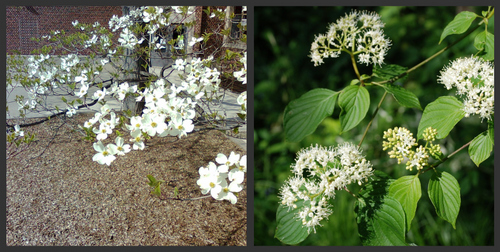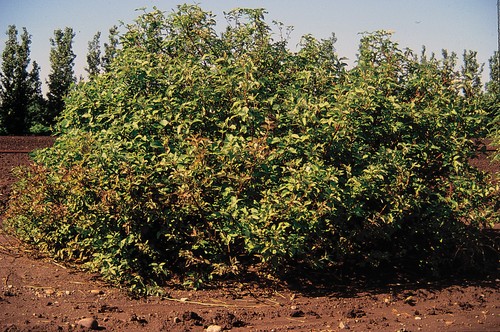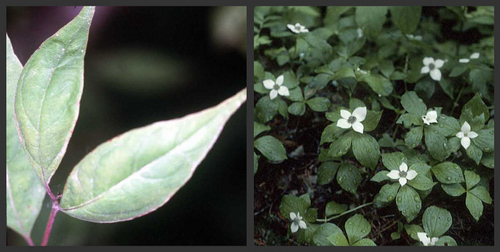Dogwoods make nice additions to your landscape
Imagine, a cozy little family of native plants whose members can be ornamental, can stabilize eroding streambanks, can feed birds and butterflies, or can serve as a groundcover. None of its members could ever be considered towering or majestic, and each one has a “best” use, but whether you’re a homeowner with full sun, mostly shade, or a mix, at least one of these could be a nice addition to your yard. The clan I’m talking about is affectionately known as The Dogwoods.

The flowers of Flowering Dogwood (Cornus florida) and Alternate-leaf Dogwood (Cornus alternifolia)
Rick Meader | Contributor
If you’re in need of an understory ornamental tree, and you have mostly light shade or dappled sun, you have two beautiful pups to choose from with quite different characters and flowers. Flowering dogwood (Cornus florida) is the dog that gets the most play and is most easily found in mainstream nurseries. It has an open, vase-like shape with twisty branches and a flat-topped crown that may be brightly colored with white or pink “flowers.” (The brightly colored petals are actually colored bracts surrounding the much more mundane and smaller greenish flowers at the center.) The tree is slow-growing and doesn’t usually get much taller than 15-25’ high, so the flowers are easily visible. The deep green, oval leaves add to its beauty.
If you need an understory tree, but want something more architectural in appearance, try Alternate-leaf dogwood (Cornus alternifolia) which is also known as Pagoda dogwood. Unlike Flowering dogwood, this dogwood has a definite layered habit, with 2-3’ between layers of branches, and its flowers are clusters of many little white flowers instead of the single “flowers” of Flowering dogwood. Those flowers become purple fruits that birds gobble up. Alternative-leaf dogwood doesn’t get as tall as flowering dogwood, only reaching heights between 10-20 feet tall. It is also more shade-tolerant and needs more moisture than flowering dogwood. Aside from the leaves, which are similarly shaped, you’d never really think they were kin if you saw them side-to-side.

Red-osier dogwood (Cornus sericea) looks and performs a lot like Silky Dogwood (Cornus amomum), down to its red bark in the winter
Photo by D.E. Herman USDA-NRCS PLANTS Database / Herman, D.E., et al. 1996. North Dakota tree handbook. USDA NRCS ND State Soil Conservation Committee; NDSU Extension and Western Area Power Administration, Bismarck
If you have more of an open, field-type setting and you want to lose some lawn, add some winter interest to the landscape and attract birds, consider the less-purchased gray dogwood (Cornus foemina). This, along with sumac, forms the gently symmetrical mounds of multiple shrubs you see in fields along the highway. The mound is actually a clone, with the scion, or original, being the tallest shrub at the center and its younger offspring forming the descending top of the mound. Individually, the gray dogwood isn’t real robust, but give it time and space and the clone can fairly quickly gobble up a good chunk of real estate, providing a lot of nesting spots for small birds in the process. This dogwood’s leaves are more narrow than the others, and its fruit is white.
Bunchberry (Cornus canadensis) is the lowest of the dogs - the dachshund of the bunch. This is mostly found “up north” and only reaches a height of 8-10” at its peak, so it’s more of a groundcover than a shrub or small tree. The flower resembles that of flowering dogwood more than alternate-leaf dogwood or the shrubs previously discussed, and the fruit looks like (and apparently tastes like) a tiny apple. It likes partial shady conditions, with moist, acidic well-drained soils. In researching this article, I found this interesting tidbit about it on Wikipedia that I couldn’t summarize if I tried:
“Each flower has highly elastic petals that flip backward, releasing springy filaments that are cocked underneath the petals. The filaments snap upward flinging pollen out of containers hinged to the filaments. This motion takes place in less than half a millisecond and the pollen experiences 800 times the acceleration that the space shuttle does during liftoff. The Bunchberry has one of the fastest plant actions found so far requiring a camera capable of shooting 10,000 frames per second to catch the action (Edwards et al. 2005).”

A closeup of Gray dogwood (Cornus foemina) leaves and a dewy bunch of Bunchberry (Cornus canadensis)
Photos by Robert H. Mohlenbrock. Cornus foemina: Robert H. Mohlenbrock @ USDA-NRCS PLANTS Database / USDA SCS. 1989. Midwest wetland flora: Field office illustrated guide to plant species. Midwest National Technical Center, Lincoln, Cornus canadensis: Robert H. Mohlenbrock @ USDA-NRCS PLANTS Database / USDA NRCS. 1995. Northeast wetland flora: Field office guide to plant species. Northeast National Technical Center, Chester.
In my Woody Plants class at the University of Michigan, they taught us an interesting identification trick for dogwoods. If you pull a leaf in half (slowly), you’ll see tiny threads of latex between the two halves. It’s unique to dogwoods. Fun, huh? So, there you have it, a group plants ranging from a stately Golden Retriever to a long-haired dachshund, sure to beautify your yard in some way. I hope you add one or two to your yard.
The spring flowers have about had it in my yard. Here’s what’s blooming now: Hairy sweet cicely, False Solomon’s Seal, Solomon’s Seal, Golden Alexander, Beardtongue, Spiderwort, Creeping strawberry bush and Common cinquefoil.
Enjoy nature everyone!
Rick is a local landscape architect with a special interest in all things natural, including native plants and the critters that eat them. You can contact him at yourland1824@gmail.com.


Comments
Rork Kuick
Mon, Jun 7, 2010 : 7:42 a.m.
Interesting bunchberry tidbit there. It's pretty seedy, and where abundant there are often better berries to eat, like blueberry. I only eat it to show off my crazy outdoor skills. When in fruit, it's rather pretty. Gray dogwood is a bit of a pest in my "yard", sending runners into all the nearby gardens and "lawn". Also, some years mine gets denuded late in summer by caterpillars - I don't know what the adult looks like (yet), but the larva seems very specific to this plant.